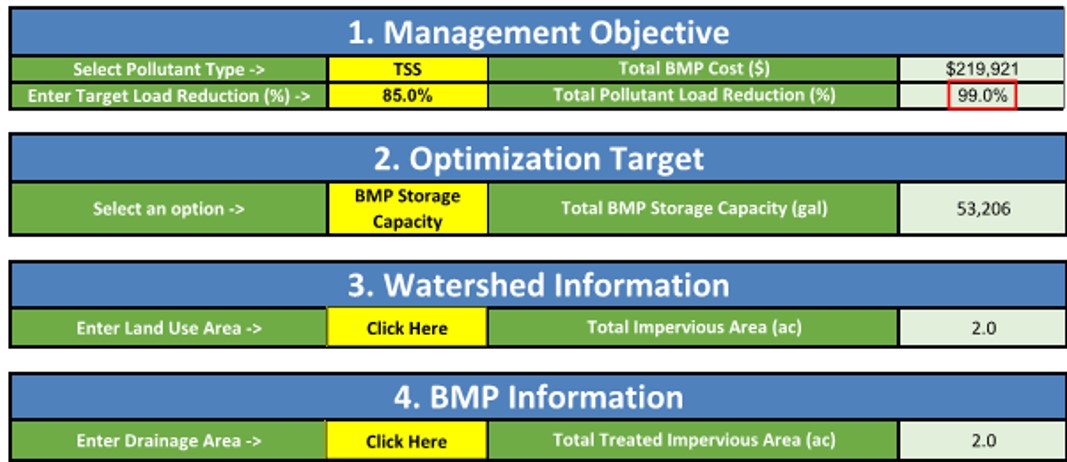As communities across New England address compliance under the MS4 General Permit, EPA Region 1 has released a digital tool to aid stormwater managers, planners and consultants in developing Stormwater Management Plans to more affordably achieve pollutant reductions. The Stormwater Nutrient Management Optimization Tool (Opti-Tool), a spreadsheet-based add-in for Microsoft Excel, is helping communities improve water quality more efficiently and at lower cost.
How it Works
Opti-Tool is fairly straightforward in design. Its spreadsheet format is easy to navigate, and clear instructions are included for input. The Opti-Tool offers Planning-Level and Implementation-Level analyses that are customized for EPA Region 1. Both levels of analysis provide cost-effective solutions that meet water quality goals.
An example below, from a pilot project in Rhode Island, shows the fields users fill in — data relating to watershed and treatment area conditions and objectives. Input runs through an optimization algorithm that produces regionally specific best management practices (BMPs) for the given conditions, location, and goals.

Opti-tool includes a database produced by the University of New Hampshire’s Stormwater Center, where researchers measure pollutant removal over time and maintain data pertaining to the capabilities of various stormwater treatment systems throughout New England. This information translates to performance curves which are easily accessed in Opti-Tool.
Benefits
The program draws on a database of best available information on stormwater urban runoff nutrient quality; long-term cumulative nutrient load and runoff volume reduction estimation; and incorporates representative stormwater control units cost information with scaling function to account for specific conditions and development density. With its built-in wealth of hard data, Opti-Tool allows users direct access to performance curves for various BMPs that are more accurate than much of what is assumed in state guidelines — often estimated through a combination of fieldwork records and theory. The added accuracy alone makes it worthwhile. Additionally, calculations performed in the background of the program save a significant amount of time in the BMP selection process.
While the tool offers multiple BMP pathways, it promotes the use of smaller scale systems that translate to cost savings. While standard regulatory guidance targets treatment for a 1-inch depth of runoff, Opti-Tool helps users identify treatment solutions that can meet water quality goals by treating a smaller portion of runoff. A system that can achieve these goals while treating less stormwater doesn’t have to be as large as one designed to the 1-inch standard. Downsizing treatment systems offers significant cost savings to stakeholders.
In line with these financial concerns, Opti-Tool’s database also includes up-to-date construction expense estimates, allowing users to better project implementation costs. The current version incorporates 2018 values for materials, construction labor, and O&M hours, but each unit can be edited by users.
Considerations
Like all technology, Opti-Tool is not a silver bullet solution for every application. Because it is still new, there are occasional bugs, easily overcome by those with a strong understanding of stormwater BMPs. The program does not cover all possible BMPs, and users should double-check performance curves with UNH or EPA, both of which keep current performance curves available online. Users who find bugs should report to EPA, as fixes are continually incorporated to improve Opti-Tool’s performance.
Despite some room for improvement, Opti-Tool offers great value to stormwater managers, planners, and consultants working to improve water quality throughout EPA Region 1.
